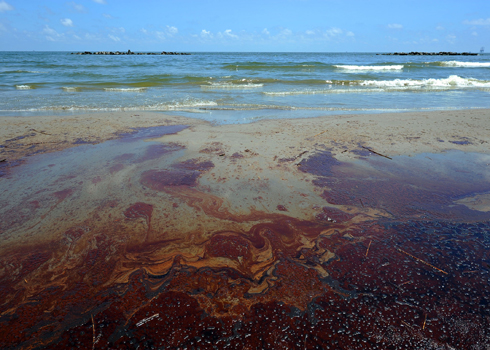Earlier this month, as BP pumped cement into the ruined blowout preventer on the bottom of the Gulf, the government released a four-page, scant-on-details report that claimed that only a quarter of the 4.9 millions of barrels of oil was left in the Gulf. The rest, they said, had been cleaned up, evaporated or dispersed into nonexistence.
And so the government essentially declared ‘Mission Accomplished!’ in the Gulf.
But skepticism quickly seeped into media reports, followed by scientific findings that there’s still oil — a lot of oil — floating around in the Gulf of Mexico.
In August, a report issued by the National Oceanic and Atmospheric Administration claimed only a quarter of the oil remained. The Wall Street Journal points out, Carol Browner, the top White House environmental adviser, had touted the report as already peer-reviewed.
The report, she said in early August, had “been subjected to a scientific protocol, which means you peer review, peer review and peer review.”
The White House also trumpeted that report, and spokesman Robert Gibbs told reporters, “I think it is fairly safe to say … that many of the doomsday scenarios that we talked about and repeated a lot have not and will not come to fruition.”
But researchers at the University of Georgia, for example, announced findings from an as-yet-unpublished report, claiming that 70 to 79 percent of the oil that leaked from the Macondo prospect is still out there.
A report due to be published in Science today by researchers with the Woods Hole Oceanographic Institute in Massachusetts confirms the existence of a giant plume underwater. In June, according to the researchers, the plume was a mile wide, 600 feet thick and 20 miles long. Although it’s likely changed since then, the lead researcher warned, “it’s going to persist for quite a while before it finally dissipates or dilutes away.”
And yesterday, a scientist with NOAA admitted that even by NOAA’s own numbers, three-quarters of the oil released into the Gulf is still there.
The senior scientist, Bill Lehr, testified at a Congressional hearing that the number NOAA claimed was total amount spilled in the Gulf — 4.9 million barrels — was skewed. Because 800,000 barrels were captured directly at the wellhead, never spewing into the ocean, the total leaked is more like 4.1 million barrels.
And of that, Lehr said, one can only really count the oil that was burned or skimmed as being out of the Gulf.
“The stuff that evaporated into the atmospheres is still in the environment. The stuff that’s dissolved into the water column, the amount that dispersed into the water column is droplets plus the amount that was on the sheen on the surface, or in small tar balls,” he said, according to transcripts from CQ-Roll Call‘s legislative tracking services.
“So, in that case, I would say most of that is still in the environment,” he said, adding that the purpose of the report was to look at oil that was recoverable. “You cannot do any recovery operation on oil that’s evaporated or is dissolved into the water column.”
Lehr added that a full, peer-reviewed report would be released in coming months. Asked why NOAA released a report without full documentation of where the numbers came from, Lehr said, “This was an oil spill emergency, not an oil spill experiment. When we put together the team, our priority was to get an answer as quickly as possible to the incident command.”
He went on to say, however, that they aren’t releasing more details yet because “It is better to take the time to do it right,” which he said means getting the report peer-reviewed.
NOAA representatives have not yet returned calls for comment.
Late update: NOAA held a conference call last night for reporters about the reports. According to accounts, the agency stood by its report.
“We’re comfortable with our numbers and as we continue to learn more about what’s happening below the surface and elsewhere, we will build that into our estimate,” Jane Lubchenco, the NOAA director, said, according to Politico.
Lubchenco, according to HuffPo, dismissed the controversy over the numbers as a “tempest in a teapot.”
“The report and the calculations that went into it were reviewed by independent scientists,” she said. “And we are pulling together the full background information that would go into a more comprehensive report.”
[Ed. note: This article was edited after publication]









